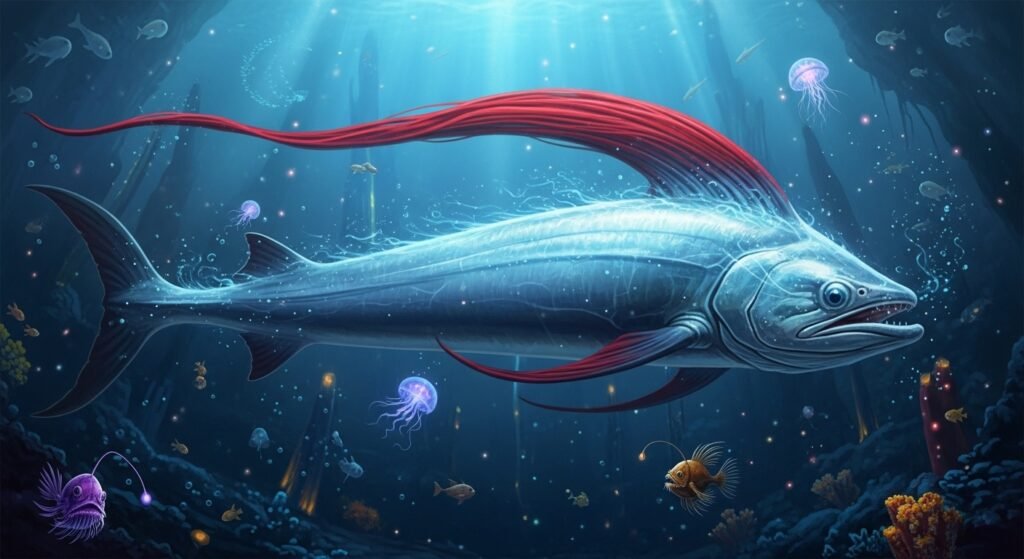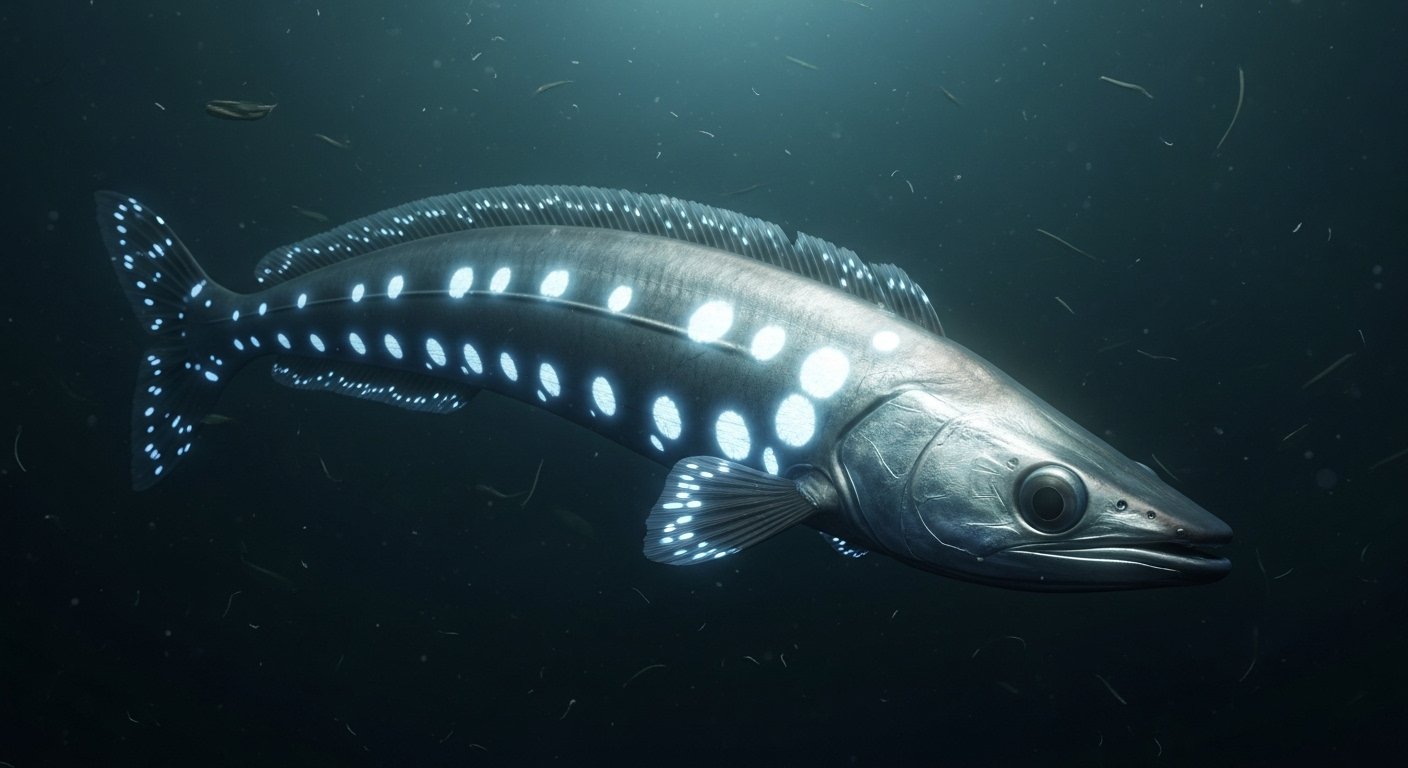The oceans are filled with strange and mysterious creatures, but few are as fascinating as the doomsday fish oarfish. With its long, ribbon-like body and eerie appearance, the oarfish has led to wild stories, especially in places where it’s seen as a sign of disaster. In recent years, the oarfish has been nicknamed the “doomsday fish” by some because people believe it shows up right before earthquakes or tsunamis. But is there any truth to this myth? Or is the oarfish simply a creature that lives deep below the ocean’s surface, far away from everyday human life?
In this friendly and simple guide, we’ll explore everything you need to know about the doomsday fish oarfish. You’ll discover where it lives, how big it grows, why people are so fascinated by it, and what science has to say about the legends. Whether you love marine biology or just enjoy a good sea mystery, this is one fish you’ll want to learn more about. Let’s dive into the deep sea and find out what makes the oarfish such an awe-inspiring—and sometimes scary—creature.
What Is the Doomsday Fish Oarfish?
The doomsday fish oarfish is a large, deep-sea fish known for its long, flat body that looks like a silver ribbon. Scientists call it Regalecus glesne, but most people know it as the oarfish. It holds the title of the world’s longest bony fish and can grow up to 36 feet long, though most are smaller. It has a small head, big eyes, and red fins sticking out from its head and body, giving it a strange and ghostly look. People rarely see oarfish alive in the wild because they live deep in the ocean, up to 3,000 feet below the surface.
Why Is It Called the Doomsday Fish?
The nickname “doomsday fish oarfish” came from the idea that the fish appears before natural disasters. In Japan and other coastal regions, sightings of oarfish have been linked to earthquakes or tsunamis. Some local legends say that the oarfish rises from the deep ocean to warn people of danger. Because of this, people often feel uneasy when an oarfish washes up on shore. Scientists call this a myth, but it’s still a powerful idea in many cultures. Even if the oarfish isn’t actually forecasting earthquakes, the stories have added mystery and fear to this deep-sea creature’s reputation.
Where Does the Oarfish Live?
The doomsday fish oarfish lives deep in the ocean, far below the range of most scuba divers or submarines. They prefer the twilight or midnight zones of the ocean, where sunlight doesn’t reach and the water is cold and dark. Oarfish are usually found in oceans all around the world, especially in tropical and temperate waters. Because they live in deep water, they rarely come near the surface. When they do appear, it’s often because they are sick or dying. This is why people sometimes find them washed up on beaches, floating near boats, or caught in fishermen’s nets.
How Big Can an Oarfish Get?
One reason the doomsday fish oarfish grabs so much attention is its size. It’s the longest bony fish in the ocean. The biggest oarfish ever recorded was 36 feet long, and some scientists think they can grow even longer. Most oarfish that wash ashore are about 10 to 15 feet in length. Their slim bodies make them look even longer. Unlike most big fish, the oarfish doesn’t have scales like a shark or tuna. Instead, its skin is smooth and silver, with a shiny glow. Its size, odd shape, and flowing red fins make it look like something straight out of a sea monster story.
What Does the Oarfish Eat?
The doomsday fish oarfish may look scary, but it’s actually harmless. It doesn’t have large teeth or hunt big sea creatures. Instead, oarfish feed on small ocean animals like krill, tiny shrimp, squid, and plankton. They open their mouths wide and suck in water along with food. Filter-like parts in their mouths catch the food while the water flows back out. They drift in the ocean with little effort, usually staying still or moving gently to snack on what floats around them. Their calm way of eating matches their peaceful nature.
How Often Are Oarfish Seen?
Because the doomsday fish oarfish lives far beneath the ocean’s surface, people rarely see it alive in the wild. Most news stories that show pictures of oarfish come from times when one has washed up dead or dying. When this happens, people get curious, and sometimes afraid, because the fish looks so strange and big. Oarfish sightings are not common, but they do happen more than many people think. Scientists believe that climate change, ocean currents, and water pollution might explain some of these sightings. Technology is helping researchers track deep-sea fish like never before, but live videos of oarfish are still rare and exciting.
Do Oarfish Really Predict Earthquakes?

Many people wonder if the doomsday fish oarfish can actually sense earthquakes before they happen. Some believe these fish are very sensitive to changes deep in the Earth’s crust. Since they live near tectonic plates on the ocean floor, it’s possible they feel vibrations or pressure changes caused by seismic activity. This idea is called the “earthquake fish” theory in Japan. However, most scientists say there’s no proof the fish can predict quakes. The fish often appear after disasters, not before. Still, the legend continues, and each time one shows up, people watch closely to see what might happen next.
Why Is the Oarfish Important to Science?
The doomsday fish oarfish is an important creature for science because it teaches us about deep-sea life. The ocean’s darkest parts are still mostly unexplored. Seeing rare species like the oarfish helps scientists learn how deep-sea animals live, grow, and survive. Studying their bodies, movements, and behaviors could give insight into how animals adapt to extreme pressure and cold. Oarfish are also useful for learning about the ocean’s food chains and ecosystems. They’re part of a mysterious world that’s hard for humans to reach, so every sighting is a valuable piece of marine research.
How Does the Oarfish Swim?
You might think a long fish like the doomsday fish oarfish would move like a snake. But it actually swims upright, with its head pointing toward the surface and its tail facing downward. This vertical swimming style is unusual and not seen in many other fish. It moves by wiggling its dorsal fin, which runs the length of its back, kind of like a ribbon in the water. This smooth, slow-motion movement helps the oarfish stay still in the water column. It doesn’t dart or chase—its body was made for quiet gliding, one of many things that make it so unique.
Can the Oarfish Be Kept in a Tank?
The simple answer is no. The doomsday fish oarfish cannot live in a regular aquarium. Oarfish are deep-sea giants that need cold, high-pressure conditions that can’t be recreated in glass tanks. Their size alone would be impossible to manage for most facilities. A few researchers have tried to study baby oarfish in tanks, but they rarely survive long. Most of what we know comes from studying dead or dying oarfish that wash up on shore. For now, the best way to learn about this creature is through ocean research and rare underwater video footage taken by deep-sea cameras.
Real-Life Sightings of the Doomsday Fish Oarfish
There have been many famous sightings of the doomsday fish oarfish in recent years. One of the most talked-about cases happened in Japan in 2010, just before a major earthquake. Around 20 oarfish were found washed up on beaches, adding fuel to the myth that they predict disasters. In 2013, beachgoers in California found a 17-foot-long oarfish, and videos and photos quickly spread online. These moments often go viral because people are shocked to learn such creatures exist. Though scientists urge caution before believing the doomsday myth, every sighting still causes a mix of excitement, fear, and awe.
Oarfish in Culture and Myth
In many cultures, the doomsday fish oarfish holds symbolic meaning. In Japanese folklore, the oarfish is called “Ryugu no tsukai,” which means “Messenger from the Sea God’s Palace.” It’s seen as a warning that something big might happen soon. In other cultures, oarfish stories are tied to sea serpents or mythical sea monsters because of their long shape and ghost-like movement in the water. Sailors in history might have seen a dying oarfish and told scary tales about it for years. The mystery of the oarfish continues to capture imaginations everywhere, even in the modern world.
Should We Worry When Oarfish Appear?
If a doomsday fish oarfish washes up near your beach, should you worry? Not really. Scientists explain that oarfish often rise to the surface when they are injured, old, or affected by changes in the water. These events are more likely due to disease, pollution, or natural currents rather than warnings of earthquakes. That said, it’s still important for scientists to study these appearances, just in case they reveal changes in our oceans. While it’s okay to be amazed or curious, it doesn’t mean a disaster is on the way. It’s better to see the oarfish as a natural wonder, not a scary sign.
FAQs
1. Why is the oarfish called the doomsday fish? It got the nickname because some people think it appears before natural disasters like earthquakes, even though there’s no solid proof.
2. How long can an oarfish grow? Oarfish can grow up to 36 feet long, making them the longest bony fish in the world.
3. Where are oarfish usually found? Oarfish are found in deep parts of oceans all around the world, especially in tropical and temperate waters.
4. Are oarfish dangerous to humans? No. Oarfish are not dangerous. They are gentle creatures that feed on small sea animals.
5. Can you keep an oarfish in an aquarium? No. They need deep, cold, high-pressure ocean conditions that cannot be recreated in fish tanks.
6. Do oarfish swim like normal fish? Not really. They swim vertically and wiggle their long dorsal fin, which makes them look like they’re floating.
Final Thoughts
The doomsday fish oarfish might be one of the strangest and most beautiful fish in the ocean. Its long body, mysterious movements, and rare appearances have captured attention for years. While many stories link it to natural disasters, science shows it’s more likely to appear when it’s hurt or lost. Still, every sighting teaches us a little more about the deep and unknown parts of our oceans. If you ever see a story about a new oarfish washing up, take a moment to learn more and share it with your friends. The more we discover about the oarfish, the more we learn about our amazing underwater world. Whether it’s a myth or a marvel, one thing is certain—the oarfish is a creature worth knowing.



